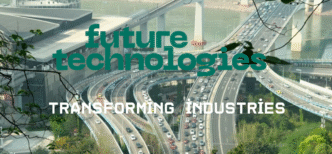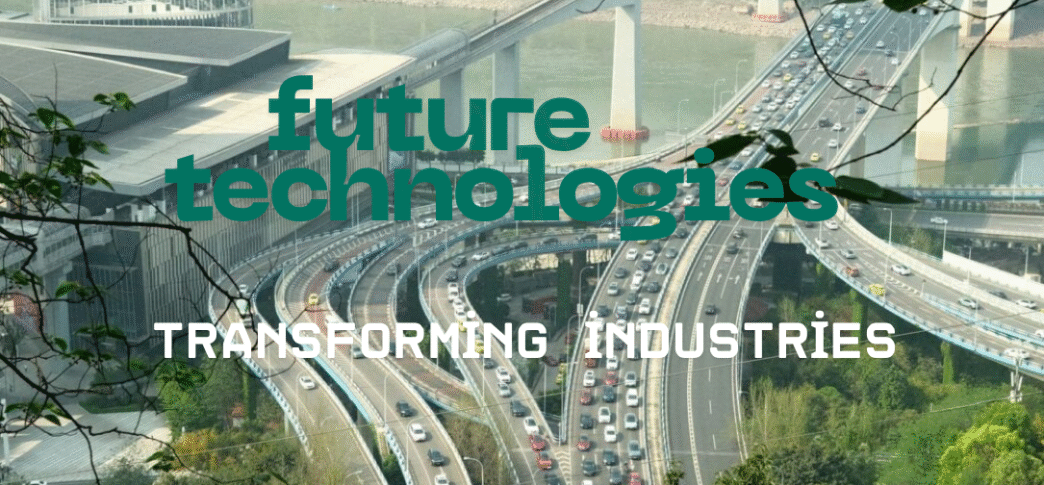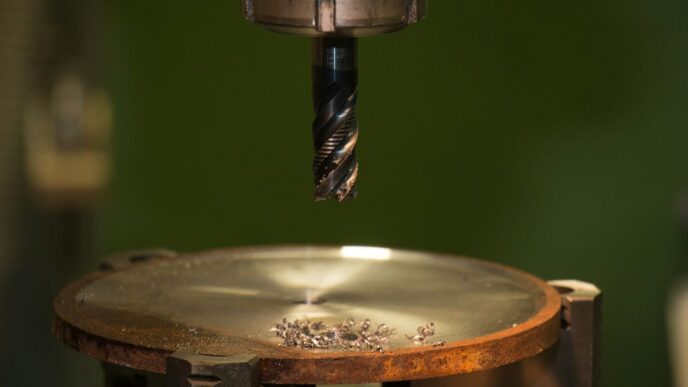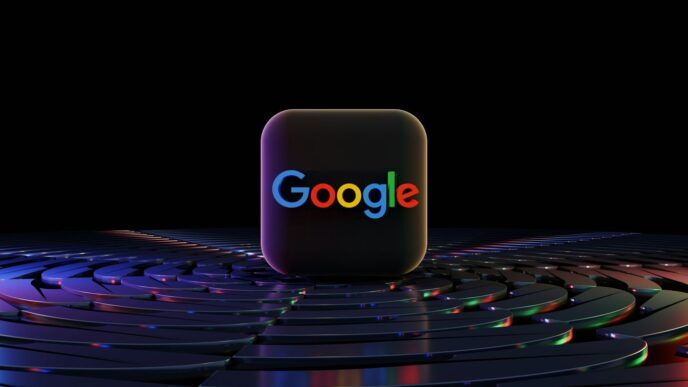The world is changing fast, and some pretty wild ideas are starting to look like they’ll actually happen. We’re talking about stuff that could totally change how we live, work, and even think. It’s not just science fiction anymore; these are real future ideas that will change the world, and they’re closer than you might think. Let’s take a peek at some of the big ones.
Key Takeaways
- Artificial intelligence is getting smarter and will change many jobs and how we do things every day.
- Quantum computing offers massive power for solving really hard problems, speeding up research.
- New biotech tools could fix genetic problems and lead to personalized health plans.
- Renewable energy is getting better and cheaper, helping us move away from old fuels.
- VR and AR are making digital experiences more real, changing how we play and learn.
Artificial Intelligence: Reshaping Industries and Daily Life

Artificial intelligence, or AI, isn’t just a buzzword anymore; it’s actively changing how we do things, from our jobs to our homes. It’s moved beyond just being a concept in movies and is now a real tool making a difference. Think about how your streaming service knows exactly what you want to watch next, or how banks use complex systems to spot shady transactions. That’s AI at work.
AI’s Evolving Role in Healthcare and Finance
In healthcare, AI is becoming a big help. It can look at medical images and spot things doctors might miss, or predict if a patient might get sick before it happens. This means better care and maybe even lower costs. For example, AI can help doctors figure out the best treatment plan based on a patient’s specific health data. In the world of finance, AI is doing a lot of the heavy lifting too. It handles tasks like managing investments, offering personalized financial advice, and keeping an eye out for fraud. These systems can process more information faster than any human team ever could. This allows financial experts to focus on more complex problems and strategy, rather than getting bogged down in routine checks. It’s all about making things more efficient and accurate. You can find out more about how AI is changing things at AI applications.
Generative AI and Creative Processes
Then there’s generative AI, which is pretty wild. You can give it a simple text description, like ‘a cat wearing a tiny hat riding a bicycle,’ and it can create an original image for you. Tools like DALL-E and Midjourney are showing us new ways to make art and design. Companies can use this to get quick illustrations for their projects, and it’s even changing how we create online content. It’s not perfect yet – sometimes the results are a bit strange – but it’s getting better fast. This technology is opening up new avenues for artists and designers, and honestly, it’s pretty fun to play with.
Automation and Enhanced Productivity
Across many jobs, AI is taking over the repetitive tasks. This means people can spend more time on the interesting, creative, or strategic parts of their work. Imagine not having to sort through endless emails or data entries; AI can handle that. This boost in productivity isn’t just good for businesses; it can lead to more fulfilling work for employees. Some jobs might change quite a bit, but the goal is to use AI to make work more efficient and, hopefully, more enjoyable. It’s about working smarter, not just harder.
Quantum Computing: Unlocking Unprecedented Processing Power
The Power of Qubits Over Bits
So, quantum computing. It sounds like something straight out of a sci-fi movie, right? But it’s actually a real thing, and it’s poised to change how we do a lot of complex stuff. Unlike the computers we use every day, which rely on bits that are either a 0 or a 1, quantum computers use something called qubits. These qubits are pretty wild because they can be a 0, a 1, or, thanks to a quantum phenomenon called superposition, both at the same time. This means a quantum computer can explore a huge number of possibilities all at once.
Think of it like this: a regular computer has to check each door in a maze one by one to find the exit. A quantum computer, with its qubits, can sort of check many paths through the maze simultaneously. This makes them incredibly powerful for certain types of problems that would take even the fastest supercomputers ages to solve, if they could solve them at all.
Revolutionizing Research and Development
Because quantum computers can handle so many variables and possibilities, they’re going to be a game-changer for scientific research. Imagine trying to figure out how a new drug interacts with the human body. That’s a ridiculously complex problem with countless molecular interactions. A quantum computer could model these interactions with a level of detail we can only dream of now. This could speed up the discovery of new medicines and treatments significantly.
It’s not just medicine, either. Materials science is another area that stands to benefit. Scientists could use quantum computers to design new materials with specific properties, like super-strong, lightweight alloys for airplanes or more efficient catalysts for chemical reactions. The ability to simulate these complex systems means less trial-and-error in the lab and more targeted innovation.
Applications in Cryptography and Materials Science
When we talk about cryptography, we’re talking about how we keep information secure, like our online banking or sensitive government data. Many of our current security methods rely on mathematical problems that are very hard for regular computers to solve. However, a powerful enough quantum computer could potentially break these codes quite easily. This is a big deal, and it’s why researchers are already working on “quantum-resistant” cryptography to protect our data in the future.
On the materials science front, the possibilities are pretty exciting. We could see:
- Development of new superconductors that work at room temperature, revolutionizing energy transmission.
- Creation of advanced battery materials for electric vehicles with much longer ranges and faster charging.
- Design of novel catalysts that make industrial processes more efficient and less polluting.
It’s still early days for quantum computing, and there are a lot of engineering challenges to overcome. But the potential for these machines to tackle problems we can’t even touch today is immense. It’s not just about faster computers; it’s about entirely new ways of solving problems.
Biotechnology and Genomics: The Future of Health and Longevity
This is where things get really interesting, especially if you’re curious about living a longer, healthier life. Biotechnology and genomics are teaming up to change how we approach health, moving beyond just treating sickness to actually preventing it and even reversing some aging processes. It’s pretty wild to think about.
CRISPR Gene Editing and Its Potential
CRISPR is a big name in this field. Think of it like a super precise molecular scissors that can go into our DNA and make changes. This isn’t just theoretical; it’s already showing promise for fixing genetic diseases that were once considered untreatable. Imagine a future where inherited conditions like cystic fibrosis or sickle cell anemia could be corrected at their source. Of course, there are big ethical questions to sort out, but the potential to alleviate suffering is immense. It’s a powerful tool that’s still being explored, but the early results are very encouraging.
Personalized Medicine and Tailored Treatments
We’re all unique, right? So why should our medical treatments be one-size-fits-all? Personalized medicine, powered by genomics, aims to change that. By looking at your specific genetic makeup, doctors can figure out which treatments will work best for you and which ones might cause side effects. This means more effective therapies and fewer trial-and-error approaches. For example, cancer treatments can be tailored to the specific genetic mutations driving a tumor, making them far more effective. This approach is a huge step towards truly individualized healthcare, making sure you get the right care at the right time. You can learn more about how biological age testing is contributing to this personalized approach.
Lab-Grown Tissues and Organs
Organ transplant waiting lists are a serious problem. Biotechnology is offering a potential solution: growing replacement tissues and even whole organs in a lab. Using a patient’s own cells, scientists can create custom-made organs, which would eliminate the risk of rejection and the need for lifelong immunosuppressant drugs. This technology could revolutionize how we treat organ failure and severe injuries. While still in development, the progress in creating functional tissues is remarkable and offers a hopeful glimpse into a future where organ shortages are a thing of the past.
Renewable Energy: Powering a Sustainable Tomorrow

The push for cleaner energy sources isn’t just a trend; it’s a necessity if we want to keep our planet livable. We’re talking about moving away from burning fossil fuels, which is a big deal for climate change and, honestly, for our own health. Luckily, there are some really cool things happening in renewable energy that are making this shift not only possible but also more practical.
Advancements in Solar and Wind Technology
Solar power is getting way better. Think about photovoltaic cells that are so efficient they can turn almost any sunny surface into a power generator. We’re not just talking about massive solar farms anymore; even rooftops are becoming mini power plants. Wind energy is also seeing some smart upgrades. New turbine designs are capturing more power with less wind, and they’re getting quieter and less intrusive. This means we can get more bang for our buck, energy-wise, without making a huge mess of the landscape. It’s pretty amazing how much power we can harness from the sun and wind these days, making them competitive with older energy methods. The UAE, for instance, is building a massive solar project combined with a huge battery storage system, setting a new standard for clean energy solutions.
Next-Generation Energy Storage Solutions
One of the biggest hurdles for solar and wind power has always been what happens when the sun isn’t shining or the wind isn’t blowing. That’s where energy storage comes in, and it’s getting a serious upgrade. We’re seeing advancements in battery technology that go way beyond what we have in our phones or cars. These new systems can store massive amounts of energy, enough to power entire communities for extended periods. Imagine a grid that can store excess solar power generated during the day and then use it to keep the lights on all night. It’s not just about batteries, either; other methods like advanced pumped hydro storage and even sand batteries are being explored. These solutions are key to making renewable energy reliable 24/7.
Reducing Environmental Impact and Costs
So, what does all this mean for us? Well, for starters, it means cleaner air and a healthier planet. By relying less on fossil fuels, we cut down on pollution and greenhouse gas emissions. This directly impacts our environment and, in the long run, our health. Plus, as these technologies get better and more widespread, the cost of renewable energy keeps dropping. It’s becoming more affordable for homes and businesses to switch to clean power. This makes sustainable living more accessible. We’re looking at a future where powering our lives doesn’t have to cost the Earth, literally. It’s a win-win situation: good for the planet and good for our wallets.
Virtual and Augmented Reality: Immersive Digital Experiences
It feels like just yesterday we were talking about VR headsets being a niche thing for hardcore gamers, but wow, things have really changed. Virtual Reality (VR) and Augmented Reality (AR) are no longer just futuristic concepts; they’re actively reshaping how we play, learn, and even interact with the world around us. VR plunges you into entirely new digital worlds, making you feel like you’re actually there. Think about stepping into a video game or exploring a historical site without leaving your living room. It’s pretty wild.
AR, on the other hand, is a bit different. It takes the digital stuff and layers it right on top of what you’re already seeing in the real world. Imagine pointing your phone at a piece of furniture and seeing exactly how it would look in your room, or using an app that shows you historical facts about a building just by looking at it. This tech is already making attractions more engaging, giving visitors new ways to interact with exhibits. The market for VR and AR is expected to explode, reaching tens of billions of dollars in the coming years.
Transforming Entertainment and Gaming
This is probably where most people first encounter VR. Forget just looking at a screen; VR gaming puts you in the game. You can physically duck behind cover, aim your weapon, and truly feel present in the virtual environment. Beyond gaming, VR is creating new forms of storytelling in movies and virtual concerts that let you feel like you’re in the crowd. It’s a whole new level of immersion.
Interactive Learning and Training Environments
Schools and businesses are starting to see the potential here too. Instead of just reading about anatomy, students can virtually dissect a human body. Mechanics can practice fixing complex engines in a safe, simulated space before touching a real machine. This kind of hands-on, risk-free practice can really speed up learning and improve skills. It’s a much more engaging way to learn than just looking at textbooks or videos.
Augmented Reality in Everyday Applications
AR is quietly making its way into our daily routines. Think about navigation apps that overlay directions onto your view of the street, or apps that help you visualize home renovation projects. Even simple things like trying on clothes virtually before buying them are becoming more common. As AR glasses become more advanced and accessible, we’ll likely see even more practical uses pop up, making everyday tasks a bit easier and more informative.
Autonomous Vehicles: Redefining Urban Mobility
Get ready, because the way we get around cities is about to get a serious makeover. Autonomous vehicles, or AVs, are no longer just a sci-fi dream; they’re quickly becoming a reality that could change everything about urban living. Think about it: cars that drive themselves. It sounds wild, but the tech is getting there, and it promises to fix some of our biggest city headaches.
Advances in Self-Driving Technology
So, how are these cars actually learning to drive? It’s a mix of super-smart sensors and fancy computer brains. Cameras, radar, and lidar (that’s like laser-based mapping) work together to “see” the world around the car. They can spot pedestrians, other cars, traffic lights, and road signs, even when it’s dark or foggy. All this information gets fed into complex computer programs that use machine learning to make split-second decisions. These systems are constantly learning and improving, getting better at handling tricky situations like unexpected road construction or sudden stops.
Impact on Traffic Congestion and Safety
One of the biggest promises of AVs is making our roads safer and less jammed. Human error is behind most car accidents, right? Well, AVs don’t get tired, distracted, or drive angry. They follow the rules precisely and can communicate with each other, potentially creating smoother traffic flow. Imagine fewer fender-benders and less time stuck in gridlock. It could mean a much calmer, more predictable commute for everyone.
Reshaping Urban Planning and Commutes
This isn’t just about the cars themselves; it’s about how they’ll change our cities. If cars can drop you off and then go park themselves somewhere else, or even pick up another passenger, we might need way fewer parking lots. That frees up valuable urban space for parks, housing, or businesses. Plus, for people who can’t drive or find it difficult, AVs could offer a new level of independence. Your daily trip to work might become a chance to catch up on emails, read a book, or just relax, instead of focusing on the road.
Blockchain Beyond Cryptocurrencies: Enhancing Security and Transparency
You know, we hear “blockchain” and usually think of Bitcoin or other digital money. But that’s just scratching the surface, really. This technology is way more than just a way to trade digital coins. It’s got this core idea of a shared, unchangeable record book, and that’s super useful for a bunch of things that have nothing to do with crypto.
Securing Personal Data with Decentralized Ledgers
Think about all the personal information floating around out there – your social security number, your medical records, your online passwords. It’s a huge target for hackers. Blockchain offers a different way to handle this. Instead of one big database that can be breached, your data could be spread out across many computers. This makes it way harder for anyone to tamper with or steal your information. It’s like having a personal diary that’s copied and given to all your trusted friends, and if someone tries to change one copy, everyone else knows it’s fake.
Improving Supply Chain Transparency and Efficiency
Ever bought something and wondered if it’s the real deal, or where it actually came from? Blockchain can help with that. Imagine tracking a product, say, a fancy coffee bean, from the farm all the way to your cup. Each step – harvesting, shipping, roasting – could be recorded on a blockchain. This creates a clear, verifiable history. You can see exactly where it’s been and confirm its authenticity. This isn’t just good for consumers; businesses can spot problems faster, like delays or counterfeit goods, and fix them.
New Applications in Various Industries
Beyond just data and supply chains, blockchain is popping up in all sorts of places. Think about voting systems – a secure, transparent way to cast and count ballots could be a game-changer for democracy. Or consider digital identity management; instead of relying on companies to hold your ID, you could control it yourself using blockchain. It’s also being explored for managing intellectual property rights, tracking ownership of digital art, and even streamlining how contracts are managed and executed. The possibilities are pretty wide-ranging, and we’re still figuring out all the ways it can be used.
Looking Ahead
So, what does all this mean for us? It’s pretty clear that the future isn’t some far-off dream anymore. These ideas we’ve talked about – from smarter computers to new ways of treating sickness and even how we get our energy – they’re already starting to show up. It’s a lot to take in, for sure. But staying curious and paying attention to these changes is how we’ll all figure out how to make the most of them. It’s about making our lives better, and maybe even helping out the planet a bit too. The journey is just getting started, and it’s going to be interesting to see where it all leads.
Frequently Asked Questions
What exactly is Artificial Intelligence (AI)?
Think of AI as making computers smart enough to do things that usually need human brains, like understanding what you say, recognizing pictures, or even making decisions. It’s like teaching a computer to learn and solve problems on its own.
How will quantum computing change things?
Quantum computers are super powerful machines that can solve really, really hard problems much faster than regular computers. They could help us discover new medicines, create amazing new materials, and even make our online information much safer.
What’s the big deal with gene editing like CRISPR?
CRISPR is like a tiny pair of scissors that can precisely change the instructions (genes) inside living things. This could help us fix genetic diseases or create better crops, but scientists are being careful about how it’s used.
Are solar panels and wind turbines really going to power everything?
Yes, we’re getting much better at using the sun and wind to make electricity. Plus, we’re developing better ways to store this energy, like with advanced batteries, so we can use it even when the sun isn’t shining or the wind isn’t blowing.
What’s the difference between Virtual Reality (VR) and Augmented Reality (AR)?
VR completely puts you into a different, computer-made world, like stepping into a video game. AR, on the other hand, adds computer images and information on top of the real world you see, like seeing directions appear on the street in front of you.
Will self-driving cars really be safe and helpful?
The technology for cars that drive themselves is getting really good. They promise to make roads safer by reducing accidents caused by human error and could make our commutes easier and cities less crowded.














